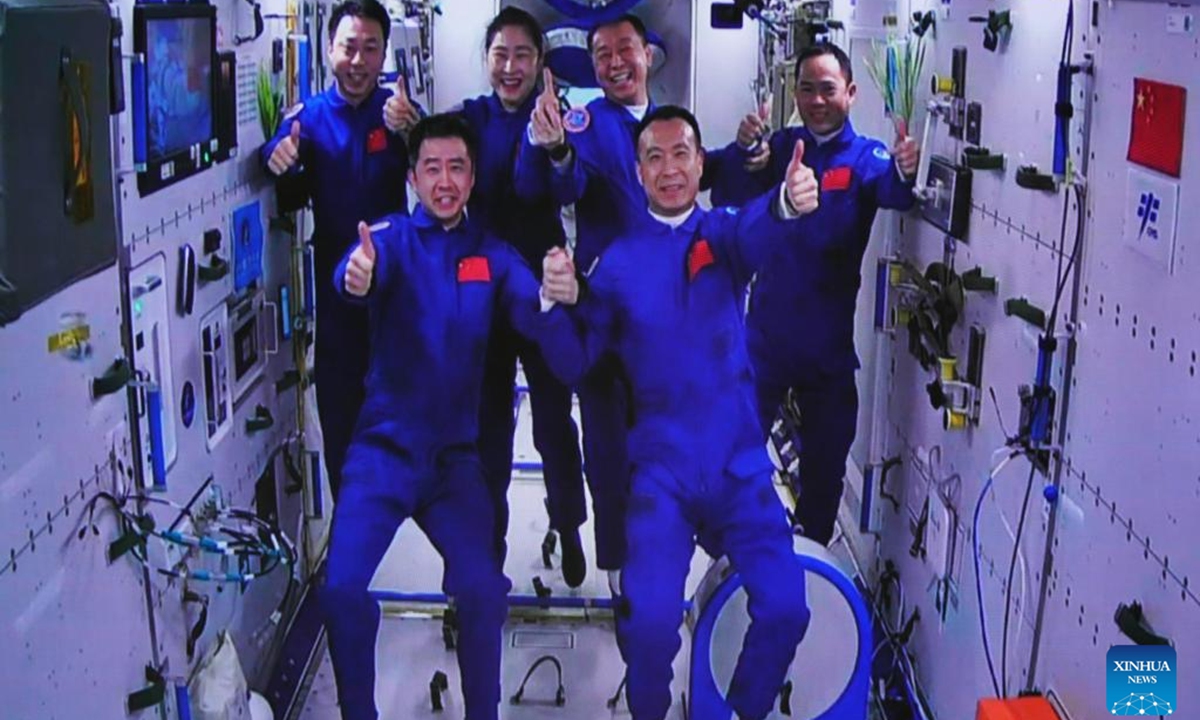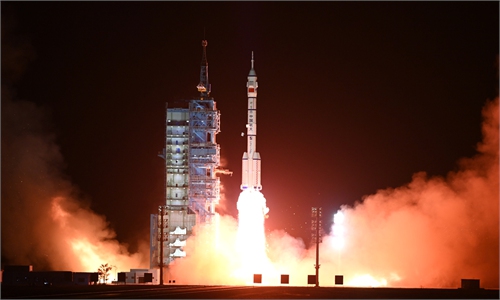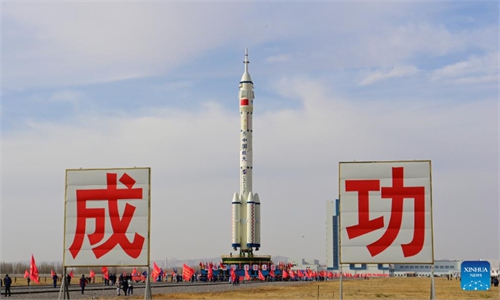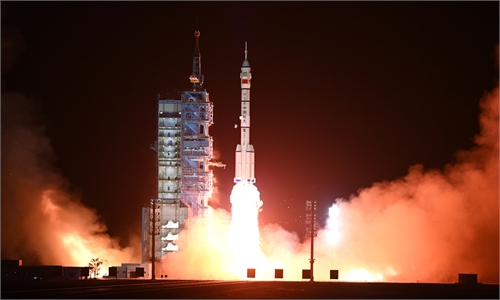Six taikonauts of two missions in historic gathering in China Space Station, give country the largest population in space

This image captured at the Jiuquan Satellite Launch Center in northwest China shows the Shenzhou-15 and Shenzhou-14 crew taking a group picture with their thumbs up after a historic gathering in space on Nov. 30, 2022. Photo: Xinhua
Marking a first in China's aerospace history, taikonauts of two manned spaceflight missions made their victorious gathering in the China Space Station early on Wednesday morning. With six taikonatus in orbit, China has surpassed the US and Russia in having the largest population in space.
Carrying three taikonauts, the Shenzhou-15 manned spacecraft launched on Tuesday night, conducted a fast automated rendezvous and docked with the China Space Station at the Tianhe core module front port at 5:42 am Wednesday.
At 7:33 am Wednesday, the Shenzhou-14 crew members who had lived and worked in space for six months and watched a live broadcast of the Shenzhou-15 launch from Earth on Tuesday night, opened the door and welcomed their Shenzhou-15 crewmates.
"Welcome, welcome… You are finally here," Shenzhou-14 mission commander Chen Dong said, receiving Shenzhou-15 commander Fei Junlong with warm greetings and a big hug, showed live footage by China Central Television (CCTV).
The six taikonauts of the two missions then took a historic group picture to commemorate their space gathering in the Tianhe core module.
Next, the two crews will execute the China Space Station's first direct handover in orbit, and they will live and work together in the space station for about five days.
Also marking a first in China's aerospace history, the space station has achieved a mega combination of six parts - three permanent modules and three spacecraft.
The total mass of the combination has come close to 100 tons, which is the largest structure of the China Space Station combination to date, the Global Times learned from the state-owned aerospace giant and space station project contractor the China Aerospace Science and Technology Corp (CASC).
It was also the first time that two Shenzhou manned spaceships docked with the Tianhe core module at the same time, the spacecraft developer the China Academy of Spacecraft Technology (CAST) told the Global Times in a statement on Wednesday.
The unique T-shape structure of the China Space Station combination with the six module/spacecraft showcases to the world the advancement and excellence of China's manned space project.
As of Wednesday, there were 13 people orbiting our home planet Earth. Besides the six taikonauts in the China Space Station, there are seven astronauts living and working in the International Space Station.
Three of the seven are from the US, three from Russia and one from Japan. That would mean China currently has the largest population in space.
The direct handover will become the new normal, which would mean that at the application and development stage of the China Space Station, "we shall always have a permanent population in space of at least three taikonauts and six during the handover every six months," Pang Zhihao, a Beijing-based senior space expert, told the Global Times.
Another space observer who requested not to be named told the Global Times that this would change the international landscape of manned space, as China would have no fewer people living in space than the traditional powerhouses of the US and Russia, and even more during handovers.
The Chinese astronaut training system revealed that the crew handover would take about five days, during which the Shenzhou-14 crew members will mainly prepare for their return to Earth, whereas the Shenzhou-15 crew will focus on setting up the space station's working status, adapting to the space environment and concluding the handover.
The handover period, with six taikonauts living and working in the space station, will also verify the maximum capability and performance of the environmental control and life support systems onboard under the fully loaded condition.
The Global Times learned that the China Space Station has two separate sets of kitchen equipment, enabling the two crews to prepare their meals at the same time, and they can choose to dine together or separately.
Likewise, there are also two bathrooms and six sleeping booths in the Tianhe and Wentian modules, which the two crews could use separately.




